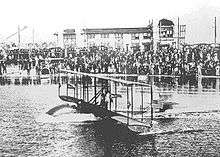Benoist XIV
The Benoist XIV, also called The Lark of Duluth, was a small biplane flying boat built in the United States in 1913 in the hope of using it to carry paying passengers. The two examples built were used to provide the first heavier-than-air airline service anywhere in the world, and the first airline service of any kind at all in the United States.
| XIV | |
|---|---|
 | |
| A Benoist XIV over Tampa Bay in Florida in 1914. | |
| Role | Airliner |
| Manufacturer | Benoist |
| Designer | Thomas W. Benoist |
| First flight | 1913 |
| Introduction | 1914 |
| Retired | 1914 |
| Primary user | St. Petersburg–Tampa Airboat Line |
| Number built | 2 |
Design and development
The aircraft was a conventional biplane with equal-span unstaggered wings with small pontoons at their tips. The engine was mounted on a pedestal aft of the cockpit and drove a two-blade pusher propeller. Accommodation for the pilot and single passenger was side by side in an open cockpit.
Operational history
The first example, given Benoist construction number 43 and named Lark of Duluth, carried joyriders over the harbour at Duluth, Minnesota through the Summer of 1913, but the endeavor was not a commercial success. The aircraft was wrecked once by Hugh Roberts, designer of the engine that powered the aircraft prior to competing in the Great Lakes Reliability Tour. The repairs and paint job left the aircraft with the partial name, "of Du".[1] Later that year, Percival Fansler, a business associate of designer Thomas W. Benoist, convinced Benoist to join him in establishing a scheduled air service between the Florida cities of St Petersburg and Tampa. Their newly formed company, the St. Petersburg–Tampa Airboat Line purchased the Lark of Duluth and another Benoist XIV to inaugurate operations. The first scheduled flight between the two cities departed shortly before 10:00 a.m. on January 1, 1914, piloted by Tony Jannus and carried former St Petersburg mayor Abram C. Pheil as its passenger for the 22-mile (35 km), 23-minute flight. Regular tickets were priced at $5.00 (equivalent to $127.62 in 2019), but Phiel had paid $400.00 ($10,000 in 2019) at auction for the ticket for the first crossing.
Over the next three months of the airline's short lifetime, the Lark of Duluth and her near-sister Florida (construction number 45) carried 1,205 passengers over Tampa Bay. At the end of March, however, the city subsidy ran out, and it proved no longer profitable to continue the service. The Lark of Duluth spent the remainder of 1914 carrying joyriders in several locations around the United States, including Duluth, Conneaut Lake, and San Diego. At this latter location it was damaged in a hard landing and pronounced unsalvageable.
Variants
- In 1984, a full-scale flying replica was constructed by Florida Aviation Historical Society for the 70th anniversary of the flight. This aircraft is now on loan to the St. Petersburg Museum of History in St. Petersburg, Florida.[2]
- A second replica of the 1913 Lark of Duluth was constructed by the Duluth Aviation Institute and FAA certified to commemorate the 100th anniversary of commercial aviation.[3]
Recreation
A full-scale replica of the Model XIV is being built by Kermit Weeks at Fantasy of Flight that they plan on flying on the centennial of Tony Jannus' first scheduled commercial flight on January 1, 2014.[4]
Specifications
General characteristics
- Crew: one pilot
- Capacity: 1 passenger
- Length: 26 ft 0 in (7.93 m)
- Wingspan: 44 ft 0 in (13.41 m)
- Empty weight: 1,250 lb (567 kg)
- Powerplant: 1 × Roberts straight-6 , 75 hp (56 kW)
Performance
- Maximum speed: 64 mph (103 km/h, 56 kn)
- Range: 125 mi (200 km, 109 nmi)
Gallery

A St. Petersburg–Tampa Airboat Line Benoist XIV begins its takeoff run on Tampa Bay for history's first scheduled airline flight, January 1, 1914. - A Benoist XIV being launched into Tampa Bay by the St. Petersburg-Tampa Airboat Line.

Tony Jannus taxis a Benoist XIV at Cedar Point, Ohio, in 1914.
See also
- Pusher aircraft
References
- Notes
- Thomas Reilly. Jannus, an American flier. p. 102.
- Thomas Reilly. Jannus, an American flier.
- "First Airliner Certified Airworthy". Retrieved 2 July 2013.
- "Airplane Buff Revs Up for Tony Jannus Re-Enactment Flight". Retrieved 12 December 2013.
- Bibliography
- Taylor, Michael J. H. (1989). Jane's Encyclopedia of Aviation. London: Studio Editions. p. 152.
- Michaels, Will. The Making of St. Petersburg. 2012 History Press Charleston pp. 89–99.
- John H. Lienhard (2007). "Tom Benoist". The Engines of Our Ingenuity. Episode 2189. NPR. KUHF-FM Houstonhttp://www.uh.edu/engines/epi2189.htm
|transcripturl=missing title (help). - Sport Aviation December 1983
- airminded.net
- Duluth International Airport website
- Servis, Richard. "Tony Jannus and the World's First Commercial Airline". Non Fiction Reader Magazine
- Letter from St Petersburg Museum of History executive director Will Michaels printed in the St Petersburg Times 2 February 2004.
- Pioneer Pilot Walter E. Lees
External links
| Wikimedia Commons has media related to Benoist XIV. |
- Contemporary postcards
- Photographs of St Petersburg Museum of History display
- "Some American Flying Boats", Flight, February 28, 1914.